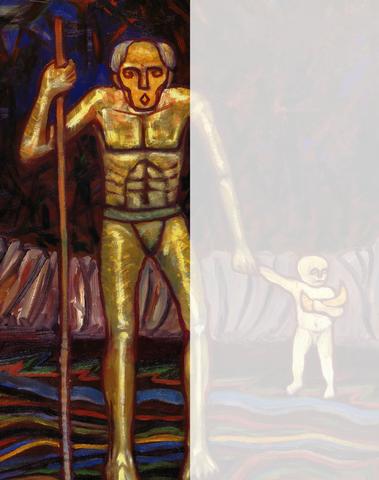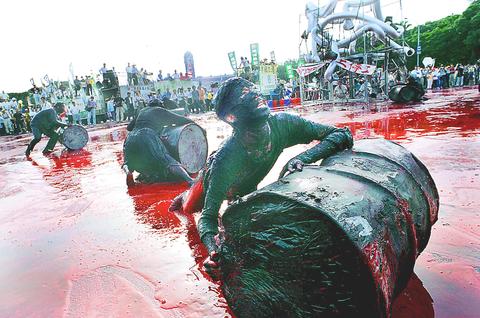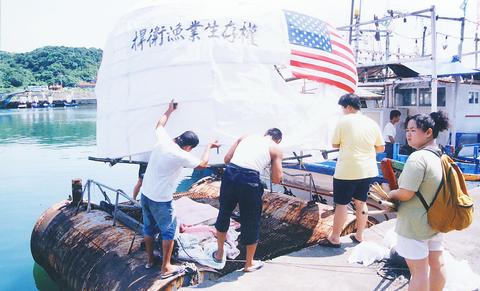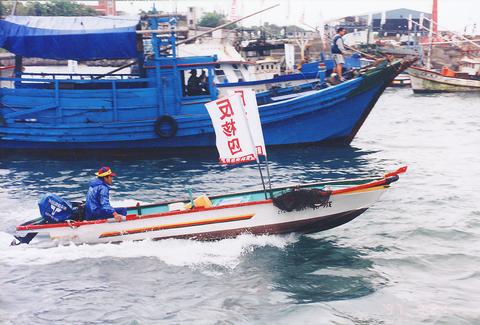Sweat drips down our faces as we gingerly make our way over the boulders towards the end of the newly constructed dock. The harsh wind off the Pacific cools us a little. We catch a whiff of the smoke from the small-scale incinerator nearby, but that is another story. On this occasion, the group of officials, activists and media are here to inspect a new dock.
"What's this?" An activist barks at Taipower officials as he picks up a red brick from beneath a boulder.
"Is this a rock?" he asks as he holds the brick in our face.

PHOTO COURTESY OF TEPU
The huddle of reporters, activists, officials and security personnel shift their attention in his direction.
He stands triumphant. On this dock, that Taipower had claimed would be built of washed rocks especially imported from Ilan County, there is clearly much other material. The officials exchange glances.
"This is enough evidence that subcontractors have been violating the stipulations of the environmental impact assessment. Taipower should halt construction of the Fourth Nuclear Power Plant until it can be resolved," the activist says.

PHOTO: CHEN CHENG-CHANG, TAIPEI TIMES
The officials agreed to look into the matter, but later said there was no evidence to warrant stopping construction.
The activists are members of the Kung-liao Anti-nuclear Self-help Association (貢
The association hopes to first halt construction on this nuclear plant and terminate the use of nuclear power in Taiwan and set up a marine-based tourist industry.

PHOTO COURTESY OF GCAA
Background
The Fourth Nuclear Power Plant was first proposed in 1978 and has been a hotly contested issue since. Despite fierce opposition from a broad network of activists throughout Taiwan and from DPP legislators, construction on the plant began in 1999.
Many thought Chen Shui-bian's election in March had sealed the fate of the plant. Chen and the DPP had long been involved in anti-nuclear struggles in Taiwan. If elected, Chen and the DPP pledged they would cancel the Fourth Nuclear Power Plant, phase out Taiwan's nuclear power program within 10 years and scuttle plans in the making at Taipower to order two more nuclear reactors sometime before 2010.

PHOTO COURTESY OF GCAA
But the battle still rages.
The government did not halt construction on the plant. According to Taipower, the NT$170 billion project is already 31 percent completed, and losses from shelving the project at this point would be around NT$67 billion to NT$89 billion.
For the past three months, the battle over the plant has been waged in a meeting room in the Ministry of Economic Affairs in Taipei, where scholars, officials and politicians belonging to a new committee formed to re-evaluate the project (核
Alternative energy
Debate within the committee has been sharp. With less than 4 percent of energy in Taiwan from local sources, pro-nuclear government agencies place a great deal of stress on energy diversity. Though still overwhelmingly dependent on foreign energy, Taiwan's reliance on oil has fallen 25 percent since 1978. The gap has been made up by a combination of coal, natural gas and nuclear energy.
Furthermore, Taiwan's peak power usage is anticipated to grow at an average rate of 4.8 percent a year until 2014. The central government is also concerned about pressure from other countries over Taiwan's carbon emissions.
"Taiwan's economic growth is still quite fast compared to the US and Europe, and although energy growth is slowing, Taiwan still needs to boost its energy supply while also working to lower CO2 emissions," says Yu Sheng-hsiung (余
Environmentalists on the committee have tried to counter the pro-nuclear arguments, and argue that the government should forsake nuclear power for increased efficiency in power generation and transmission, reduce energy use, develop renewable energy resources and change Taiwan's industrial structure.
Petrochemicals, steel, cement, paper and other power-consuming industries accounted for 7 percent of Taiwan's GDP over the past seven years, but consumed more than one-third of Taiwan's power, according to Wang To-far (王
If Taiwan could move away from such energy intensive industries -- as well as increase the efficiency of existing plants and promote renewable energy resources -- it would reduce the need for nuclear power, say many environmentalists.
But pro-nuclear forces are less than convinced.
"It's not feasible to radically change Taiwan's industrial structure as the environmentalists say. A lot of families depend on jobs from those industries they want to cut," says re-evaluation committee member Lee Min (李敏), a professor of Nuclear Engineering at National Tseng Hua University. After 12 grueling six-hour weekly debates about the facts and merits of the plant (archived for internet viewing at: http://www.hichannel.hinet.net/moean4/ -- a first in Taiwan and perhaps the world), scholars and officials with widely varying viewpoints will try to hammer out some kind of a consensus on Sept. 15, when the committee will submit its report to the Ministry of Economic Affairs. Then the ball will again be in the central government's court, which is expected to make a final decision before October.
Bounced check
Chen Shui-bian's oft-repeated campaign pledge to halt construction on the plant was arguably the first to bounce after he took office.
On July 11, 1999 at the Jenho Temple (
"We don't recognize the re-evaluation committee," says Lin Fu-lai (
"[The Re-evaluation Committee] shouldn't be set up to re-evaluate whether to build the plant or not. Hasn't the DPP already evaluated the issue? It should be a committee to plan out how to shut the plant down," claims outspoken Wu Wen-tung (吳文通), another member of the Kungliao Anti-nuclear Self-help Association.
Lu Chen-tsang (
"Chen's resolve to ditch the plant hasn't changed, but now that he's in power he has to pay special attention to the process by which it is shut down," he says. Faced with stiff opposition, Taipower has done its best to sway the minds and hearts of people throughout Taiwan. Taipower and the Atomic Energy Council (AEC) have spent billions of NT dollars on "education campaigns" and distributed thousands of books, flyers, posters to all groups of society. Even primary school pupils have been provided cartoon books that espouse the benefits of nuclear-generated electricity.
Large numbers of residents remain opposed to the plant, despite the propaganda. In 1994, Kungliao held a local, non-binding referendum and 96 percent of the population voted against the plant. In 1996, Taipei mayor Chen Shui-bian held a similar referendum in Taipei, in which 53 percent voted against the plant to 46 percent in favor.
International dimensions
Taiwan's record with nuclear issues has not been good. In addition to nearly 5,000 houses constructed with rebar containing radioactive waste across the island, fires have occurred in nuclear power plants, low-level nuclear waste stored on Orchid Island is leaking. But "Chen's greatest worry about the plant comes from the US and Japan," says Lai Wei-chieh bluntly.
Although viewed as a local issue for Taiwan, the interests connected to the construction of the plant span the globe. US multinational GE won the contract for the plant's two reactors, valued at US$1.8 billion, but quickly subcontracted much of the actual bid to the Japanese giants Mitsubishi and Hitachi. These are not the kind of firms you want to have as enemies. They are large, well connected, and inhabit every corner of the globe. To give some idea of the size of these corporations, consider this: the combined revenue of GE, Mitsubishi and Hitachi was US$302 billion last year, just shy of Taiwan's total GDP of US$310.5 billion in the same year.
And with nuclear plants no longer being built in the US, Taiwan's Fourth Nuclear Power Plant is a crucial part of GE's Asian strategy.
"If GE can't get Lungmen built [as a result of political changes ushered in by Chen's victory] they won't be able to build [a nuclear power plant] in China,'' a competing US vendor official was quoted as saying in Nucleonics Week, a weekly journal for the nuclear industry, soon after Chen's victory.
But multinational contractors and subcontractors are only the very beginning of the story by which the nuclear power industry plugs Taiwan into the world.
The storage of 97,000 barrels of low-level radioactive waste from Taiwan's six reactors are right now being stored on Orchid Island, a small island located to the southeast of Taiwan, and home to a population of nearly 3,000 indigenous Tao, one of Taiwan's aboriginal tribes. Of these, 3,000 have rusted and some are leaking, which is thought to be the main cause of both a high cancer death rate and birth defects affecting over 50 children on the island.
But there is hope for the Tao: Taipower would like to dump the waste on some other country. The agency is scrambling to find a country willing to take the waste, and despite opposition, the agency has already met with officials from North Korea, China and Russia about accepting the waste.
The last international link comes in the form of the human imports required to actually build the plant. Scores of Thai laborers are being paid paltry wages to do Taipower's dirty work in Kungliao. Anti-nuclear activists have been pursuing an international strategy of their own. In March 1997, activists from Taiwan teamed up with counterparts in Japan to protest at the headquarters of Mitsubishi, Hitachi and Toshiba against the export of Japan's nuclear reactors. Korean activists also came to Taiwan in 1997 to protest Taipower's signing of an agreement with North Korea to ship up to 200,000 barrels of low-level nuclear waste to North Korea, a country with no experience in handling radioactive waste.
The increasingly regional basis of anti-nuclear activism should come as no surprise, as Asia's tigers and would-be dragons are a key part of expansion plans for the first world multinationals that control the nuclear industry.
Legacy of martial law
One hundred and five years ago, after defeating China in the Sino-Japanese War, the Japanese landed at Kungliao to bdgin the long and bloody process of taking control of their first colony. Without a navy protecting Taiwan, there was little opposition to the arrival of the Japanese forces.
But there will be resistance to the Japanese ships that try to land at Kungliao, say local activists. The reactor for the Fourth Nuclear Power Plant is being built in Japan, and is too large to be lugged to Kungliao by train or truck from Taiwan's deep-water ports. Instead, a new dock is being built just to unload the massive turbines and reactor cores for the plant. Fishermen from Kungliao are planning to blockade the ships as they try to unload their mammoth wares. There are rumors that international environmental groups will join them.
Direct action by residents to stop the plant should come as no surprise. It is a mirror image of the repressive environment the plant was born into. The project began when Taiwan was still under martial law. Repression of government dissidents was still common, either by state police forces or gangsters working in connection with the government, activists say.
"And up to a couple years ago the heidao [gangsters] would still find ways of making your life uncomfortable if you got involved in protests," complains Wu.
Activists say the contractors constructing the plant have extensive connections with Taiwan's underworld.
"But just because a contractor is in bed with the heidao doesn't mean they don't do quality work. That's one of the weird things about Taiwan," says Lai Wei-chie (
"If we kicked the heidao out of the construction business, we could lower construction costs by about 70 percent," speculates Wu.
Another legacy of Taiwan's martial law period is the incredible power that technocrats wield. Taiwan's techno-bureaucrats have exercised extraordinary power in Taiwan for decades, holding commanding positions in a maze of state-owned enterprises, government agencies and so on.
"Things are still as bureaucratic as before. We're still completely left out of the decision-making process, still fighting against the same bureaucrats. Government policy should decided on from the bottom up. [The government] shouldn't be ramming their policies down our throats," says Wu.
Awaiting judgement
With the formation of the re-evaluation committee three months ago, the central government successfully dropped control rods into the boiling issue of the plant. The results of the re-evaluation committee are about to released, and when the wraps come off the plant, the issue could go critical once again.
Regardless of what the government decides, the fight over Taiwan's energy policy is not going away.
"Even if the government decides to build a natural gas plant, there will still be opposition, whether it be over the pipeline for the gas or a new harbor for ships bringing the LNG to Taiwan," says Professor Lee Min. "It's not easy to build anything in Taiwan anymore."

April 14 to April 20 In March 1947, Sising Katadrepan urged the government to drop the “high mountain people” (高山族) designation for Indigenous Taiwanese and refer to them as “Taiwan people” (台灣族). He considered the term derogatory, arguing that it made them sound like animals. The Taiwan Provincial Government agreed to stop using the term, stating that Indigenous Taiwanese suffered all sorts of discrimination and oppression under the Japanese and were forced to live in the mountains as outsiders to society. Now, under the new regime, they would be seen as equals, thus they should be henceforth

With over 100 works on display, this is Louise Bourgeois’ first solo show in Taiwan. Visitors are invited to traverse her world of love and hate, vengeance and acceptance, trauma and reconciliation. Dominating the entrance, the nine-foot-tall Crouching Spider (2003) greets visitors. The creature looms behind the glass facade, symbolic protector and gatekeeper to the intimate journey ahead. Bourgeois, best known for her giant spider sculptures, is one of the most influential artist of the twentieth century. Blending vulnerability and defiance through themes of sexuality, trauma and identity, her work reshaped the landscape of contemporary art with fearless honesty. “People are influenced by

Last week, the the National Immigration Agency (NIA) told the legislature that more than 10,000 naturalized Taiwanese citizens from the People’s Republic of China (PRC) risked having their citizenship revoked if they failed to provide proof that they had renounced their Chinese household registration within the next three months. Renunciation is required under the Act Governing Relations Between the People of the Taiwan Area and the Mainland Area (臺灣地區與大陸地區人民關係條例), as amended in 2004, though it was only a legal requirement after 2000. Prior to that, it had been only an administrative requirement since the Nationality Act (國籍法) was established in

The remains of this Japanese-era trail designed to protect the camphor industry make for a scenic day-hike, a fascinating overnight hike or a challenging multi-day adventure Maolin District (茂林) in Kaohsiung is well known for beautiful roadside scenery, waterfalls, the annual butterfly migration and indigenous culture. A lesser known but worthwhile destination here lies along the very top of the valley: the Liugui Security Path (六龜警備道). This relic of the Japanese era once isolated the Maolin valley from the outside world but now serves to draw tourists in. The path originally ran for about 50km, but not all of this trail is still easily walkable. The nicest section for a simple day hike is the heavily trafficked southern section above Maolin and Wanshan (萬山) villages. Remains of